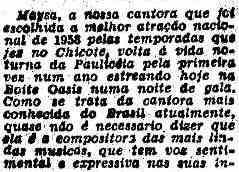São Paulo, being the largest city outside Japan with a Japanese population was the aim of many Japanese acts in the 1950s & 1960s. Here are some of the few acts we spotted on the music media lately.
Akira Mita visits São Paulo some time in the early 1960s, judging by his album cover which is a photo montage but great nonetheless.

Matsuo Kazuko.
9 January 1965 - Japan's recording artist Matsuo Kazuko sings at Cine Niteroi, on Rua Galvão Bueno and later at midnight she performs at Club Ichiban, on Rua Alvaro Carvalho, 49, owned by Tetsuro Ono & Cia.
# 102, February 1966 - 'Melodias' was one of the few media outlets that recorded the visits of Japanese acts of Brazilian shores. This time is Akira Matsushima, born in Tokyo on 5 July 1944.
'Melodias' # 146, November 1969 - popular Japanese singer Iumi Kaoru visits Sao Paulo in 1969; she'd been Japan's entry at IV International Song Festival in Rio de Janeiro that year.
Kyu Sakamoto was the greatest of Japanese acts outside Japan. This is his album 'Sukiyaki' released in Argentina.
The Argentine liner notes fail to explain how 'Ue o Mui Te Aruko' (I look up as I walk) became 'Sukiyaki' but they translate it to Spanish: 'En rigor, 'Sukiyaki' es una melancólica canción:
"Levanto la vista mientras camino / recordando los felices dias de primavera / Peró esta noche me siento muy solo. Y levanto la vista al caminar, contando las estrellas con los ojos llenos de lágrimas.
La dicha está más allá de las nubes / más allá de la comba del cielo. Yo levanto la vista mientras camino para que mis lagrimas no puedan caer / aunque mi corazón está lleno de tristeza, porque esta noche me siento muy solo. La tristeza se oculta detrás de las estrellas / nos acecha escondida en la sombra de la luna. Levanto la vista mientras camino, para que mis lágrimas no puedan caer / recordando esos felices dias del otoño / porque esta noche me siento muy solo."
Kyu Sakamoto presented 'Sayonara, Sayonara' at the 3rd International Pop Song Festival in Rio de Janeiro in 1968.
Kyu Sakamoto and a young Chico Buarque in Rio, October 1968.






























































